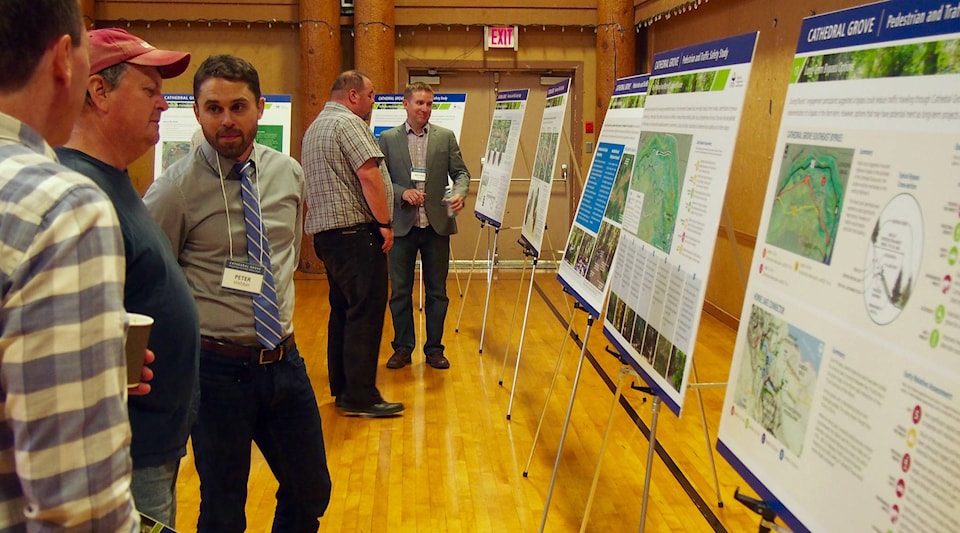MIKE YOUDS
SPECIAL TO THE NEWS
Options for improving pedestrian safety at Cathedral Grove include a pedestrian overpass, new parking areas west of the main grove and a centre barrier to prevent illegal turns.
But a more costly, long-term option to ease the hazardous bottleneck through the park — a highway bypass widely favoured by valley residents — would not solve the main problem, according to the B.C. Ministry of Transportation and Infrastructure.
Ministry and provincial park staff hosted an open house on Thursday, June 20 at the Port Alberni Friendship Centre, unveiling the results of public input intended to fix the chronic congestion on Highway 4 where it bisects the old-growth attraction.
Last fall’s first stage of public engagement yielded about 500 suggestions, said Peter Webber, transportation planner. Those were evaluated and narrowed to a series of options based on environmental impacts on the old growth trees, costs and three key issues — pedestrians, traffic and parking, he said.
READ: Provincial dialogue begins over Cathedral Grove traffic
“We’re not ruling out any options,” he said, including potential highway bypass routes north and south of the park. However, a bypass would not be completed within the established time frame of zero to five years and would not address the highway hazard, diverting only 10 to 20 percent of traffic.
One such route is the Horne Lake Connector linking Hwy. 19 with Hwy. 4, a well-studied secondary corridor to Port Alberni with “significant capital costs” and environmental impacts. Three other route options would skirt the main grove through the park’s southeast ridge—steep, challenging and costly terrain for a highway.
“While we’re not ruling it out, it’s not addressing the issue in the short term,” Webber said.
Options for improving parking include a highway centre barrier, to prevent the dangerous illegal turns, the addition of U-turn routes, shoulder barriers to separate parking from the travelled road and the addition of about 50 stalls.
“We are looking at additional parking capacity outside of the existing area,” but again, that would be outside of the short-term options, Webber said. “It will require a lot more assessment.”
Along with consulting the public, the ministry has studied the safety issue first hand, determining that 530 people, on average, cross the highway in a typical two-hour period during peak season.
A pedestrian underpass, initially reviewed, was assigned low feasibility due to possible flooding and impact on tree roots. An overpass, however, could take several forms with access ramps parallel to the highway of extending into the grove.
The information presented at the public events and the feedback questionnaire are available at engage.gov.bc.ca/cathedralgrove. The questionnaire is open until July 31.
Considering the success of the last attempt to enhance safety in the Grove, the ministry is probably wise to proceed with caution this time. An attempt by B.C. Parks to address the safety issue by adding parking lots in the grove was scuttled after protests 15 years ago.
“We’re working together to achieve something safe for everybody,” said Monica Valdes Garcia, supervisor of B.C. Parks’ Arrowsmith area.
The few residents who attended the afternoon open house seemed satisfied with the consultative approach.
“I’m happy to see this, but they’ve got a long way to go,” said Mary Ann Krivensky.
Her husband, Richard, pointed to the potential hazard of a tree falling on an overpass, possibly closing the highway. He strongly favors the Horne Lake Connector, “the sooner, the better.”
“We were going to have this done years ago,” he said. “People are going to get hurt.”
Webber acknowledged they are going to extraordinary lengths, but pointed out that the situation is unique—a major artery passing through the middle of a popular tourist attraction that is environmentally sensitive.
This fall, the ministry will announce its next step and further opportunities for public engagement.
